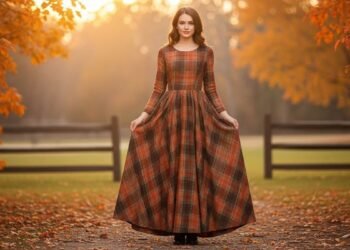As we turn the page to 2025 & 2026, the fashion world is buzzing with anticipation for the next big trends that promise to redefine our wardrobes. This year, we’re seeing a thrilling fusion of past and future, where retro flair meets modern sustainability.
Think bold, revamped ’70s silhouettes and ’90s minimalism, all crafted from innovative, eco-friendly materials. But it’s not just about looking back; it’s about moving forward with smart fabrics that are as functional as they are fashionable.
For anyone passionate about the intersection of style and technology, these years will be a landmark in fashion history. Get ready to embrace a future where fashion not only looks good but also does good.
Its time to ditch your old trends and have a look to whats coming ahead.
Fashion Forecasting – Future Trends To Look Forward
Eco-Luxury:
The concept of eco-luxury in fashion combines high-end style with environmentally friendly practices. As awareness about environmental impacts grows, luxury brands are responding by adopting sustainable methods.
This trend involves using materials that are either recycled or sourced in a way that does not deplete natural resources. Additionally, eco-luxury emphasizes ethical production processes that ensure fair wages and safe working conditions.
Consumers are increasingly seeking products that are not only luxurious but also responsible and , driving this trend forward as a new standard in the luxury market.
For those interested in embracing these trends without breaking the bank, explore our tips to make the latest trends affordable, providing practical advice to stay stylish and sustainable on a budget.
Digital Fashion:
Digital fashion refers to virtual clothing designed for online platforms and augmented reality experiences. As our interactions increasingly occur in digital realms, fashion brands are creating virtual garments that can be worn by avatars in games or social media settings.
This shift towards digital arenas parallels trends seen in other sectors of the industry, such as the evolving golf fashion trends, which highlight how traditional styles are being reimagined for modern consumers.
Regenerative Fabrics:
Regenerative fabrics are groundbreaking in the sustainability sector. These materials go beyond reducing harm; they actively improve the environment. Examples include fabrics that can biodegrade naturally and add nutrients back to the earth or textiles designed to absorb carbon from the atmosphere.
The push for regenerative fabrics is fueled by the need to address the negative environmental impacts of traditional fabric production and waste. This trend is gaining momentum as both consumers and producers look for ways to help reverse climate change through fashion.
Adaptive Clothing:
Adaptive clothing is designed to be stylish yet functional for people with disabilities, addressing needs such as ease of dressing and comfort. This trend is growing as awareness of inclusivity increases, and the fashion industry recognizes the diverse needs of its consumer base.
Adaptive clothing often includes features like magnetic closures instead of buttons, adjustable designs, and soft, stretchable fabrics. By focusing on accessibility, this trend not only improves quality of life but also supports the idea that fashion should be for everyone.
Futuristic Minimalism:
Futuristic minimalism in fashion reflects a desire for sleek, simple aesthetics that prioritize functionality and sustainability. This trend features streamlined silhouettes, neutral color palettes, and versatile garments that can be worn in multiple ways.
The minimalist approach reduces waste in production and consumption, appealing to environmentally conscious consumers. It also resonates with a modern lifestyle that values ease and efficiency, making it a practical yet stylish choice for the future.
Cultural Fusion:
Cultural fusion in fashion celebrates the blending of different global traditions and aesthetics. This trend is driven by increased global connectivity and cultural exchange, allowing designers to draw inspiration from a diverse tapestry of cultural elements.
Garments may combine patterns, materials, and techniques from various cultures, creating innovative and eclectic styles. Cultural fusion not only comes from traditional fusion but it sometimes also draws its inspiration from western clothing that is already influencing global fashion.
Coming Fashion Trends for Women
For women’s fashion in 2025, we can anticipate several influential changes in silhouettes, colors, and design elements that reflect broader cultural and technological shifts. Here’s a closer look:
In 2025, fashion is expected to highlight a variety of dress types that cater to both aesthetic appeal and practicality, reflecting broader trends in sustainability, technology, and global influence on fashion.
Here are a few dress types that are anticipated to be prominent:
1. Wrap Dresses:
The wrap dress will continue to be a staple due to its flattering fit and versatility. In 2025, expect to see wrap dresses in sustainable fabrics like Tencel and recycled polyester.

Designs will feature bold prints, including botanical and geometric patterns, making them suitable for both casual and formal settings.
2. Maxi Dresses:
Maxi dresses will dominate with their comfort and style, especially in lightweight, breathable materials perfect for the increasing global temperatures.

These dresses will likely incorporate eco-friendly dyes and finishes, with details such as ruffles, tiers, and pleats to add movement and interest.
Similarly, the trend towards comfortable yet stylish choices is also evident in this year’s wedding fashion trends, where the focus on adaptability and elegance remains key.
3. Shift Dresses:
The shift dress will make a comeback, appealing to those who favor a minimalist aesthetic. Expect to see shifts in monochrome palettes and block colors, crafted from innovative fabrics like recycled nylon or blended organic fibers.

The simplicity of their cut makes them a canvas for futuristic accessories and digital-inspired patterns.
4. Boiler Suits:
As workwear elements continue to influence mainstream fashion, the boiler suit will be reimagined as a statement piece.

These will be designed with adjustable features like removable sleeves or convertible lengths, using durable yet stylish materials that cater to both function and fashion.
5. Modular Dresses:
Emphasizing functionality, modular dresses will be popular for their adaptability. These dresses will come with detachable components, allowing the wearer to alter lengths, sleeves, and silhouettes according to the occasion, weather, or personal preference.

This adaptability will be enhanced with smart fabrics that can adjust their properties, such as color or thermal insulation, based on environmental conditions.
6. Culturally Inspired Dresses:
Reflecting the trend of global craftsmanship, dresses will feature elements inspired by traditional garments from around the world, such as kimono sleeves, African prints, or South American embroidery.

These dresses will not only be fashion statements but also celebrations of cultural heritage, made from authentic materials sourced ethically from communities around the globe.
These dress types are derived from major industries that influence fashion trends and reflect an overarching theme of blending tradition with innovation.
Dress Details for Latest Fashion Trends
Silhouettes:
Fluid Forms: Expect to see a lot of fluid, flowing silhouettes that offer comfort and a sense of freedom. Oversized, loose-fitting pieces that drape elegantly will be popular, providing a blend of comfort and chic style.
Structured Minimalism: On the flip side, there will also be a trend towards more structured and sculpted forms that offer a sharp, tailored look. This will include cinched waists, strong shoulders, and architectural influences that create bold, defined shapes.
Layered Looks: Multi-layering will be a key trend, allowing for versatility and adaptability. This includes detachable collars, adjustable hemlines, and modular accessories that can transform the function and style of a garment.
Colors:
Earth Tones: Reflecting a move towards sustainability and nature, earthy colors like olive green, terracotta, sand, and muted blues will dominate. These colors are soothing, easy to wear, and versatile for styling.
Vibrant Hues: To counterbalance, expect bursts of vibrant colors such as saffron yellow, cobalt blue, and emerald green, providing a bold statement within otherwise neutral ensembles.
Pastel Palettes: Soft pastels will continue to be popular, especially in spring and summer trends, offering a fresh, airy feel that plays well with the more substantial, textured fabrics.
Designs:
Textural Contrasts: Mixing different textures will be prevalent, combining materials like silk and heavy wool or integrating technical fabrics with traditional weaving methods.
Functional Details: Clothing will feature more functional elements, like built-in pockets, adjustable straps, and weather-resistant fabrics, blending practicality with style.
Eco-conscious Embellishments: Expect to see natural and recycled embellishments, such as wooden beads, recycled glass buttons, and organic cotton lace, enhancing the garment’s aesthetic while keeping sustainability at the forefront.
Prints and Patterns:
Nature-Inspired Prints: Floral and botanical prints will evolve in a more abstract and artistic direction, representing nature in a stylized or exaggerated form.
Geometric Patterns: Bold geometric shapes will be popular for their visual impact and ability to blend with both casual and formal styles.
Futuristic Motifs: With a nod to technological advancements, digital and pixelated patterns or holographic effects might emerge, offering modern trends with futuristic look.
Materials:
Innovative Eco-Fabrics: Development in eco-friendly materials will continue, with increased use of biodegradable textiles, regenerated fibers, and fabrics made from new sustainable sources like algae or CO2.
Luxurious Blends: Fabrics that blend luxury with function, like silk-wool hybrids or linen-cashmere, will be popular for their comfort, durability, and chic appearance.
Wrapping Up
As we look towards 2025 & 2026, the future of fashion intertwines sustainability, innovation, and cultural richness.
Embracing these trends means more than just style; it’s about making responsible choices that influence both industry and society. Let’s step into these years ready to make fashion a force for good.




